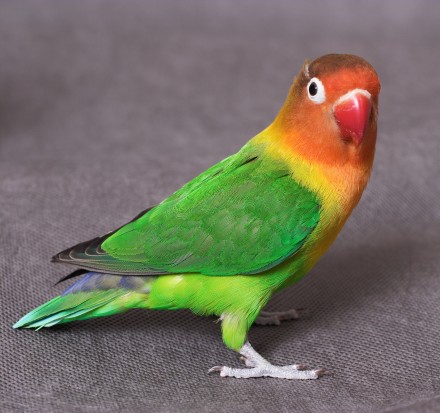

Lovebirds are very good at hiding the fact they are ill. This is a behaviour that stems from being in the wild where showing such a weakness could make them a target for predators or could even see them abandoned by their colony because of it. Therefore, it is very important to watch the bird and get to know their personality so there is a better chance of spotting illness.
One of the most common series of problems that lovebirds suffer are relating to their diet. Principally this is because they are seed addicts and while this provides them with a lot of what they need in their diet, it can also lead to problems if not balanced out with other food.
The main reason for this is that seed is high in fat. This can lead to obesity in birds just the same as it can in humans and a seed only diet can also lead to deficiencies in vitamin A and calcium. Obesity can lead to fatty liver disease and also arthritis.
How to combat this: green leafy vegetables, fruits with contain beta-carotene such as apples and carrots are both ways to naturally introduce vitamins safely to the diet. A calcium block is another option or a liquid calcium in water if the block is ignored.
Another option is sprouting seeds. This is a simple process that sees the seed use up its most fatty part to produce the small plant sprout, leaving behind all the beneficial elements. It is a great dietary balancing agent and different sprouted seeds have different benefits. For example, oily seeds like rape and niger have a lot of protein and carbohydrates which starchy seeds such as millet and canary seed are high in minerals, vitamins, enzymes and chlorophyll.
Lovebirds are one of the species who are most at risk from a condition called Psittacine Beak and Feather Disease or PBFD. This is a circovirus that infects and then kills the cells that make up the feathers and beak and also has a devastating effect on the immune system, which can lead to the bird contracting other infections.
The disease can be fatal, or can bring on another infection that is fatal in its own right. It can be passed from bird to bird so any bird that may have it should be quarantined away from others immediately. There is no known cure but vaccines are being developed to help prevent infection.
Symptoms include:
The abnormalities in the beak and feathers are the main visual sign that something may be wrong and can include short, clubbed feathers, curly feathers, narrow shafts which are prone to breaking and feathers which are deformed. In the beak, this shows as an overgrown upper beak, deformed shape and a beak that is prone to splitting and breaking.
Laying eggs doesn’t sound like a bad thing for a bird but chronic egg laying can cause serious effects on the long-term health of the bird. It is often the case that the eggs laid are infertile and aren’t laid because they have mated but because some other factor has made the hen think she needs to produce and lay the egg.
The main reason that egg laying can be a worry is that it leads to calcium deficiency. Simply put, the bird takes calcium from her body to make the egg and if she is laying frequently and not replacing it, she can make herself ill.
Another part of the condition is egg-binding due to a condition called hypocalcaemia. This is when calcium levels are low, the uterine muscles fail to contract and the egg cannot be pushed out, leading to egg binding. Hypocalcaemia can in itself lead to seizures and brittle bones that can easily fracture.
How to combat: you can’t stop a bird laying eggs but there are a few things to do to either persuade her not to or to make sure she is strong enough to survive it. Firstly, don’t remove the eggs she has laid, let her finish laying then sit on them. Normally incubation is around 21 days so once she starts incubating she won’t lay again for at least this time, allowing her body to recover. If you are worried about hygiene from the eggs lying around, you can obtain dummy eggs which look identical to the real thing but aren’t.
The other thing to make sure is that she is taking in plenty of calcium in to her system to replenish what she uses. This can be done through calcium blocks or in the water or through food. Chicken eggs, baked in the oven to remove any bacteria, are a good source of natural calcium and can be smashed up into tiny pieces to be easy to digest.
Among the common respiratory illnesses that affect birds, lovebirds are prone to aspergillosis, bacterial infections including pneumonia and parrot fever or psittacosis.
Aspergillosis is a fungal infection that isn’t infectious but is highly fatal. It infects the respiratory tract but also spreads to other organs at various stages. It can be controlled if caught early enough and treated with anti-fungal medication. See our special piece on the subject for more information.
Polyoma is another illness passed through the respiratory tract that affects young birds and is transmitted from one to another, possibly also through the egg. It starts with feather abnormalities, loss of appetite and a delay in emptying their crop (where the parents deposit the food). It can lead to bleeding from the follicles where the feathers develop and can be treated if caught early enough.
Sometimes birds fall ill despite our best attempts to stop it and there is nothing we can do. But by knowing your bird’s personality, you have a better chance of spotting when something may be wrong and getting them to a vet in time to help them before it’s too late.
Copyright © 2005-2016 Pet Information All Rights Reserved
Contact us: www162date@outlook.com